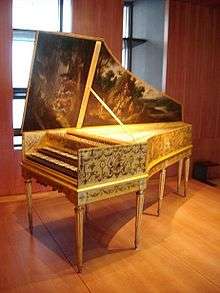Musical Instrument Museum (Brussels)
| Musée des instruments de musique/Muziekinstrumentenmuseum | |
 Antique instrument on display at the museum. | |
 Location within Brussels | |
| Established | 1877 |
|---|---|
| Location |
Montagne de la Cour/Hofberg 2, B-1000 Brussels |
| Coordinates | 50°50′34″N 4°21′32″E / 50.842836°N 4.358831°E |
| Type | Musical museum |
| Nearest car park | No |
| Website |
www |
The Musical Instruments Museum (MIM) is a music museum in central Brussels, Belgium. It is part of the Royal Museums for Art and History and internationally renowned for its collection of over 8,000 instruments.
History
Originally attached to the Royal Conservatory of Brussels with the purpose of demonstrating early instruments to students, the MIM collection was created in 1877 with a collection of a hundred Indian instruments given to Belgian King Leopold II by Rajah Sourindro Mohun Tagore in 1876 and the collection of the celebrated Belgian musicologist François-Joseph Fétis, purchased by the Belgian government in 1872 and put on deposit in the Conservatory, where Fétis was the first director.
Its first curator, Victor-Charles Mahillon, greatly expanded the already impressive collection so that, by the time of his death in 1924, the MIM consisted of some 3,666 articles, among which 3,177 were original musical instruments. He was noted of his astute judgments in obtaining these large augmentations by calling on philanthropists, mixing with erudite amateurs who sometimes became generous donors, and through friendly relations with Belgian diplomats in foreign posts, who sometimes brought back instruments from beyond Europe.
The monumental five-volume catalogue of the collection Mahillon commissioned between 1880 and 1922 also included four versions of his essay on the methodical classification of both ancient and modern instruments, which was to serve as the basis for the organological Hornbostel-Sachs classification systems still used today. Beginning in 1877, Mahillon also created a restoration workshop in the MIM where he employed and trained a worker, Franz de Vestibule, to restore damaged articles and make copies of unique instruments in other public collections.
Mahillon's successor at the Conservatory, François-Auguste Gevaert, organized several successful concerts of professors and students playing early instruments in the 1880s.
After the First World War, donors and philanthropists became rarer, with only about a thousand instruments entering the collections between 1924 and 1968, and Belgium's famed instrument builders began becoming scarcer. Until 1957, the curators taking their turn at the head of the MIM, with Ernest Closson (1924–1936), his son Herman (1936–1945), and René Lyr (1945–1957) limiting themselves through the two world wars to preserving the already collected instruments, in not always satisfactory conditions. Ernest is notable for editing several articles on Belgian makers for the National Biography and devoting a long monograph to La facture des instruments de musique en Belgique, which appeared at the 1935 Universal Exhibition held in Brussels.
With the arrival of the esteemed Latinist Roger Bragard, curator between 1957 and 1968, larger budgets became available from the Ministry of Culture as exhibits were renovated, new personnel were hired, concerts were again organized, and new rare pieces were collected. His efforts were continued by his successors René de Maeyer (1968–1989), Nicolas Meeùs (1989–1995), and Malou Haine (1995–2009).

Exhibits
The museum's collection represents Belgian musical history (including Brussels' importance in the making of recorders in the 18th and 19th centuries and as the home of instrument inventor Adolphe Sax in the 19th century), European musical traditions, and non-European instruments. Mechanical instruments are shown in the basement, traditional instruments on the ground floor, the development of the modern orchestral instruments on the first floor, and keyboard and stringed instruments on the second floor.
Visitors are given infrared headphones in order to listen to almost 200 musical extracts of the instruments on display.
Information is provided in French and Dutch, though not in English.
Among the notable pieces of the collection are the famous Rottenburgh Alto recorder, instruments invented by Adolphe Sax, a unique set of giant Chinese stone chimes, and the only existing copy of the luthéal, an instrument used by Ravel.
Location
The museum's current location, as of 2000, is in the former Old England department store, built in 1899 by Paul Saintenoy out of girded steel and glass in the art nouveau style as well as an 18th-century neo-classic building designed by Barnabé Guimard.
Located at Rue Montagne de la Cour/Hofberg 2 on the Mont des Arts/Kunstberg, the museum sits next to Place Royale/Koningsplein and in front of the Magritte Museum.
External links
| Wikimedia Commons has media related to Musical Instrument Museum, Brussels. |
- Official museum website
- Entry on Musical Instrument Museum from the BBC h2g2
- Musical Instrument Museum information from Tripadvisor
- Photos of the Musical Instrument Museum from Have Camera Will Travel
Coordinates: 50°50′34″N 4°21′32″E / 50.84289°N 4.358844°E
